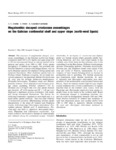Mostrar o rexistro simple do ítem
Megabenthic decapod crustacean assemblages on the Galician continental shelf and upper slope (north-west Spain)
| dc.contributor.author | Fariña Pérez, Antonio Celso | |
| dc.contributor.author | Freire, Juan | |
| dc.contributor.author | González-Gurriarán, Eduardo | |
| dc.date.accessioned | 2005-10-28T10:35:19Z | |
| dc.date.available | 2005-10-28T10:35:19Z | |
| dc.date.issued | 1997 | |
| dc.identifier.citation | Marine Biology, vol. 127, n. 3 (Feb. 1997), p. 419-434 | es_ES |
| dc.identifier.issn | 0025-3162 | |
| dc.identifier.uri | http://hdl.handle.net/2183/81 | |
| dc.description | The original publication is avaliable at www.springerlink.com | |
| dc.description.abstract | The structure of megabenthic decapod crustacean assemblages on the Galician (north-west Spain) continental shelf (100 to 200 depth) and upper slope (200 to 500 m) was analyzed based on surveys carried out in autumn and spring, from 1980 to 1987. Forty species belonging to 19 families were caught. The portunid crab "Polybius henslowii", a species with pelagic phases, was the most abundant species, but displayed strong spatial and temporal fluctuations. Other dominant species were the Norway lobster "Nephrops norvegicus", the portunid "Liocarcinus depurator", the galatheids "Munida intermedia" and "M. sarsi", and the shrimps "Solenocera membranacea", "Plesionika heterocarpus", "Pasiphaea sivado" and "Dichelopandalus bonnieri". Total abundance and biomass (average values excluding Polybius henslowii = 255 individuals and 2.06 kg/30 min tow) and species richness and diversity, Ht (6.85 species and Ht = 1.45 per tow) displayed a significant positive correlation with depth, and strong interannual fluctuations. The factors determining community organization were depth and, to a lesser extent, spatial structure. There was clear evidence of bathymetric zonation, differentiating between species characteristic of the slope ("D. bonnieri" and "Pasiphaea sivado"), shelf-slope edge ("Macropipus tuberculatus", "Pontophilus spinosus", "Munida sarsi", "S. membranacea", "Processa spp.") and shelf ("L. depurator", "Macropodia tenuirostris", "Paguridae" and "Chlorotocus crassicornis"). The spatial zonation was related to changes in oceanography and sediment along the continental margin. "Goneplax rhomboides", "N. norvegicus", "C. crassicornis" and "Alpheus glaber" are benthic species which generally exhibit burrowing behaviour, and they were found mainly in the southern area where there are fine sediments due to the outwelling from the Rías Baixas. Different benthopelagic shrimps ("Pontophilus spinosus", "Plesionika heterocarpus", "Processa spp." and "Pasiphaea sivado") were typical of the zone just north of Fisterra, characterized by a convergence of water masses bringing about an increase in productivity due to upwelling. The benthic anomuran and brachyuran crabs "Munida intermedia", "M. sarsi", "L. depurator" and "Macropipus tuberculatus" were characteristic of the northwestern zone between Fisterra and Estaca, where the infauna reaches high biomass despite coarser sediments with a lower concentration of organic material than in the southern area. Lastly, both the "Paguridae" and "Macropodia tenuirostris" were species typically found in the waters in the northern shelf. Based on interannual changes in assemblage structure, two periods could be distinguished: between 1980 and 1984, when "Polybius henslowii", "D. bonnieri" and "Pasiphaea sivado" had abundance peaks; and another period from 1985 to 1987 when "L. depurator", "Munida intermedia", "M. sarsi" and "Macropipus tuberculatus" increased in abundance | es_ES |
| dc.format.mimetype | application/pdf | |
| dc.format.mimetype | text/plain | |
| dc.language.iso | eng | es_ES |
| dc.publisher | Springer-Verlag | es_ES |
| dc.title | Megabenthic decapod crustacean assemblages on the Galician continental shelf and upper slope (north-west Spain) | es_ES |
| dc.type | info:eu-repo/semantics/article | es_ES |
| dc.rights.access | info:eu-repo/semantics/openAccess | es_ES |
Ficheiros no ítem
Este ítem aparece na(s) seguinte(s) colección(s)
-
GI-BPRM - Artigos [13]






